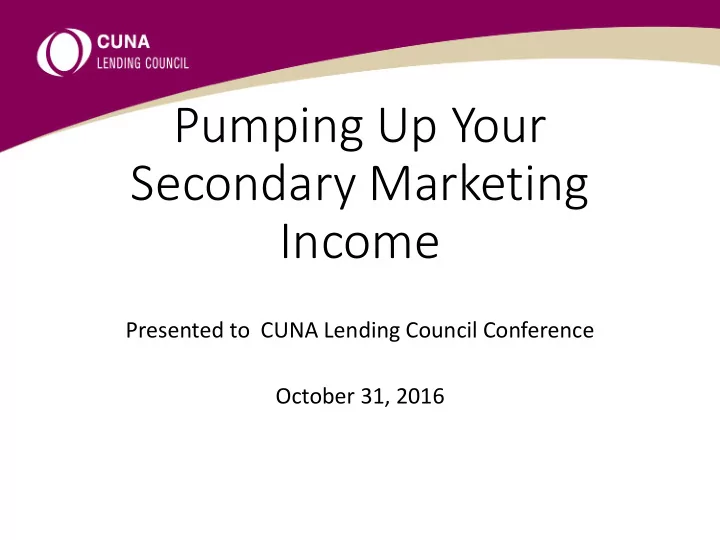

Pumping Up Your Secondary Marketing Income Presented to CUNA Lending Council Conference October 31, 2016
Agenda Expanding Secondary Income Overview Ways to Pump Up Your Income Transition to Mandatory Commitments Move to Using Multiple Investors Monitor Fall Out Through Better Reporting Conclusion
Overview – Expanding Income About More Than Just Money Rising rates mean tighter margins Even steady rates will result in less volume As margins reduce, more income will drive more volume Results in wider array of competitive mortgage lending products More members needs met Competitiveness will matter in the future Reputation as a lender will matter Attracting staff will critically rely on competitiveness
Overview – Options to Expand Income Better prices Investors improve buy price Better investors Same products but better execution Better hedging Manage hedge ratios and fall out assumptions Better internal procedures Income affected by operational processes
Transition to Mandatory Delivery Mandatory delivery increases income Pricing significantly better than best efforts Margins can increase if outside of market standard Lowest best efforts margins reflect consistent fall out, and low risk in switch to mandatory Minimal risk in mandatory commitments Most CU pipelines have predictable closing rates Market interest rate changes do not materially affect fall out rate Greater flexibility to use multiple investors Best efforts eliminates option to switch investors
Mandatory Delivery Strategies Determine Fall Out Assumption Usually 20% fall out is appropriate starting position Range of fall out assumptions narrow for credit unions (15% to 25%) Monitoring fall out will be important component Implementation Alternatives Depending on volume, can take commitments for 80% of locks daily Smaller lenders can take loan-by-loan commitments on 4 out of every 5 locks
Mandatory Delivery Income Income gains can be significant Best efforts to mandatory spreads can be 25 – 60 bps Assuming originations of $10 M with 20% fall out implies 25 bps on $8 M, or $20,000 per month Risk is difference between anticipated and actual fall out Monitoring fall out and adjusting coverage key to maximizing Fall out variance impact must be considered relative to income $500,000 in extra loans close (85% pull through) Price change down one point – effect is a $5,000 loss But need to compare to $20,000 gain Pair offs are not a risk – but are an aspect of mandatory deliver
Multiple Investors Use driven by volume increases Most of the benefit is in niche type products Requires sufficient volume to warrant managing extra investors Pricing differs between investors For products, i.e. RD loans, 20 year fixed For loan characteristics, i.e. MPF loans, high balance Product requirements may vary Delivery and underwriting requirements different Jumbo conforming/high balance, low balance loans
Multiple Investors Strategies Implement process to track daily pricing Add new investors to access pricing Monthly volume may limit number of investors Identify pricing differentials regularly Best analysis occurs over time as pricing changes Review pricing results compared to delivery/product rules Specific examples of use of multiple investors High balance loans (Freddie, Fannie, FHLB) RD loans (Freddie, Fannie) ARM loans (Freddie, Fannie) Low balance loans (Fannie)
Multiple Investors Income Additional income can be significant High balance loans - $2 M to Freddie implies $30,000 income increase per month RD loans - $1 M to Fannie implies $6,000 income increase per month ARM loans - $1 M to Freddie implies $15,000 income increase per month Low balance loans - $2 M to Fannie implies $10,000 increase increase per month Issues associated with using multiple investors Matching AUS findings with investor/expertise to underwrite to investor ultimately buying the loan Sufficient volume to warrant multiple investors
Fall Out Management Improve use of mandatory commitments through better reporting Issue is not minimization of fall out, but consistency of fall out Process change has minimal impact on day to day operations Does not require production/delivery adjustments Key to effective use of multiple investors Fall out expertise makes switching loans easier
Fall Out Management Strategy Reporting regularly is the most important aspect Both historical data and up to date information are critical Three reporting strategies to monitor fall out Instant report – a monthly breakdown of fall out versus lock loans with a 12 month rolling average Historical reporting – monthly/quarterly report on discreet set of loans identifying loan characteristics and fall out results Financial reporting – cost associated with withdrawn/canceled locks versus income associated with additional coverage for closed loans
Fall Out Management Income Improving fall out percentage accuracy can result in more income Based on 100% coverage of $10 M in new locks, adjusted hedging strategy could result in $20,000 income per month Effective hedging strategy can bring hedge cost to $0 Issues associated with fall out management Incorporating fall out into process requires more oversight Review of reports and revisions to fall out needed Ability to manage fall out ratios on a loan level eventually required
Summary Nathan Hagen, President Secondary Marketing Resources, Inc. (617) 794-8935 nhagen@esmresources.com
Recommend
More recommend